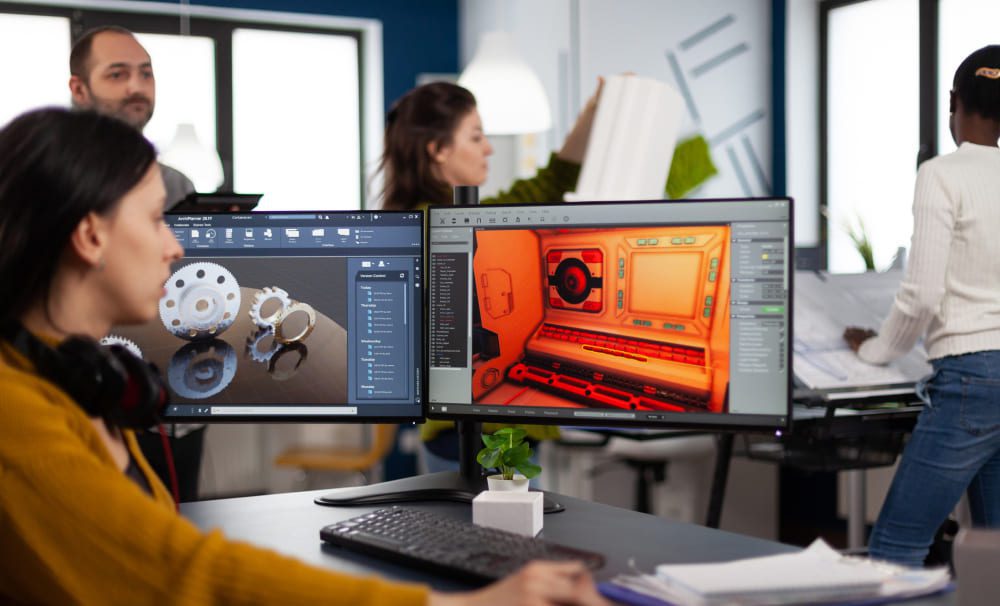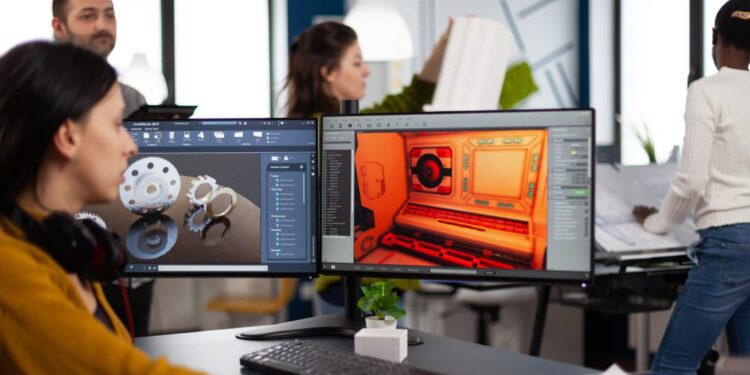In the fast-paced video game industry, dozens of professions contribute to quality game production. These highly coveted positions include game designers, animators, producers, artists, and programmers, who all work together to create a fun, playable product that gamers will enjoy.
[ads position=”top”]

Video game design is a competitive field with a variety of career paths. There are many ways to become a videogame designer, each of which requires some education and experience. Once you know what a video game designer does and how to become one, you can decide if this profession is right for you.
In this post, you can find the duties of a videogame designer, the main steps to becoming one, and where you can look at various educational routes to the profession.
What does a video game designer do?
As you know, a video game designer creates visual content for games. He uses graphic design techniques and programming knowledge to create characters, worlds, and interactive stories.
One of the primary responsibilities of a videogame designer is to create visually appealing content that engages the user. Designers usually work closely with a team of developers, writers, animators, and testers to build a successful game. They can also meet with the sales and marketing staff to develop advertising for the games.
Video game designers can work on specific aspects of a game or focus on the overall content. There are different types of games that a designer can create, including:
- Console games
- Mobile games
- Computer games
- Massively multiplayer online games
How do you become a videogame designer?
There are so many paths that you can use to become a video game designer. But the most important are these some common steps:
- Earn a high school diploma.
- Obtain a bachelor’s degree.
- Get experience.
- Create a resume with a portfolio.
- Learn new skills.
- Stay involved.
What does every point mean? Let’s find the answers!
1. Earn a high school diploma
Every current position for video game designers requires at least a high school diploma or equivalent. You can take computer coding classes and graphic design programs in high school. If you plan to earn a bachelor’s degree, try to get a high GPA to be a more competitive candidate for college admission. You should also aim for the high ACT or SAT scores.
In determining whether you should pursue a bachelor’s degree, you can research job vacancies in your desired location or company. You can find out if most video game design positions require a college degree or high school diploma as a minimum requirement. You also have to decide if you want to get a more specialized design education by going to college.
2. Obtain a bachelor’s degree
Planty of videogame designers have a bachelor’s degree in graphic design, multimedia design, or a related field. Some universities offer a degree specifically for video game design. The curriculum includes software development, 2D and 3D animation, programming languages, and computer design.
You should also consider taking one or more internships while studying in college. You can get hands-on experience in the industry during your Internship and begin to learn valuable skills. You can also network with professionals in the field, which increases the likelihood of excellent recommendations after graduation.
You can get internships at design or software development firms, which can be good for a career as a video game designer. You may find an internship with a gaming company in your location.
[ads position=”mid”]
3. Get experience
Video games are a competitive field. It’s essential to gain experience right out of high school. You can find a job as an associate designer right out of college, although you will likely have to look for similar jobs in related fields. Working as a graphic designer, animator, and software developer are all positions that can help you gain experience and build your portfolio.
Additionally, you can volunteer or get experience developing small games. You can look for volunteer opportunities where you can practice your design and programming skills. Moreover, many videos and tutorials on the Internet help you create small games.
4. Create a resume with a portfolio
A well-designed resume and an eye-catching portfolio make you a more attractive candidate for hiring managers. When writing your resume, add your experience and any projects you have designed. If possible, specify the particular games you created, for which platform, and what software and coding languages you used. In the “Skills” section of your resume, list the design programs and programming languages you know and list any “soft” skills you possess, such as communication and teamwork skills.
A portfolio is a great way to show an employer all your skills and experience. You can add to your portfolio:
- Game screenshots
- Link or download to game level
- Videos of gameplay
- Gaming reviews
- Link to a demo reel
- Back-end programming
Your portfolio can also include a personal biography, work experience, and additional accomplishments. Of course, your portfolio should reflect your unique design qualities and personality.
5. Learn new skills
You should continue to learn and develop new skills and abilities as you build your career as a videogame designer.
As software and coding languages constantly evolve, it is essential to keep up with developments to be a leader in your field. As a video games designer, you can read industry news and blogs to learn about the latest trends and constantly practice your skills to improve them.
Last but not least, if you are interested in leadership or management positions, there are some soft skills you can develop to be successful. Managing projects often requires communication, teamwork, organization, and time management. These skills can help you lead a design team or manage various design projects.
6. Stay Involved
You can find many video game and design associations that offer membership.
Membership in an association or organization will help you network with other professionals and make valuable connections in your field. Many organizations hold conferences with workshops, lectures, and discussions where you can learn more about different aspects of design and development. Several associations also offer professional certificates to prove your qualifications in a particular subject.
What is a Video Game Designer’s workplace?
Video game designers usually work for game companies. As a rule, they work in an office or studio surrounded by other designers and programmers. Such an environment can become very stressful, especially when a deadline is approaching or a server crashes.
Video game designers must be able to think on the spot and have developed problem-solving skills. Video game design is not an exact science; it is subject to errors and problems that need to be quickly noticed and fixed. This field requires rapid adaptation and constant innovation as technology improves and video games become more accurate and realistic.
Good teamwork, especially at large game companies, is essential to meeting deadlines and launching games on time. Your communication skills and the art of persuasion are needed to convince team members that an alternative method is more effective or to present new ways that might be useful for game design.
[ads position=”bot”]
Designers also need to work together to create concepts and parts of the game that fit together harmoniously, as if only one person was designing the game based on their vision.
And now you can answer your main question about video game design – is it right for you or not? In this post, you found the duties of a videogame designer, the basic steps, how to become one, and where to look at the various educational routes to the profession.


